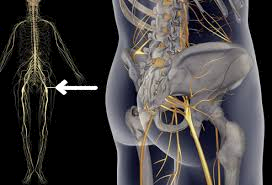Accepting New Patients
Serving the Chicagoland Area

Sciatica Pain Causes, Symptoms, & Treatments
The nerve roots coming out of the spinal cord into the lower back is the sciatic nerve. This is the thickest nerve in your body and goes down through the buttock, with its branches leading down the back of the leg to the ankle and foot.
When pain is associated with sciatic nerve it is known as sciatica; that is the feeling of tingling or numbness that can radiate down into your legs.
Diagnosis:
With the help of a medical history and physical exam, sciatica will be diagnosed by your doctor. X-rays and MRI may also be used to determine the cause of sciatica.
Causes:
Irritation in the sciatic nerve can give rise to this kind of pain. Some common causes are
- Slipped or herniated disc (most common)
- Degenerative disc disease (breakdown of discs, which act as cushions between the vertebrae)
- Lumbar spinal stenosis (narrowing of the spinal canal in the lower back)
- Pregnancy
- Spondylolisthesis(a condition in which one vertebra slips forward over another one).
Other factors that can lead to sciatica are
- Being Overweight
- Not exercising
- Wearing high heels
- sleeping on a mattress that is too soft

Symptoms of Sciatica Pain
- A constant pain on one side of the buttocks
- Pins and needles feeling in your legs or feet
- Burning or tingling down the leg
- Pain in the buttock or leg that becomes worse when sitting, standing or walking
- Weakness, numbness or difficulty in moving the leg or foot

Sciatica Pain Treatments
Some patients say that sciatica pain goes away with time, but initially some medications and exercises are needed. Pain may also be relieved by:
- Avoid sitting unnecessarily
- Take walks, even if they are short
- Exercise, especially to strengthen your core
- Maintain a healthy diet- Diabetes can increase your chance of nerve damage
- Quit smoking, as nicotine can damage spinal tissue, weaken bones, and speed the wearing down of vertebral disks.
- Take acetaminophen (Tylenol) or non-steroidal anti-inflammatory drugs (NSAIDs) such as ibuprofen (Advil) or naproxen (Aleve)
- Apply an ice pack for approximately 15 minutes several times a day to help with pain and swelling. After a few days you can try switching to a hot pack or heating pad, but if pain persists you can rotate the hot and cold packs and/ or see your doctor
After trying the above treatments, if the pain doesn’t improve then your doctor will likely suggest physical therapy, injections such as steroids, stronger medication, or even surgery for severe cases.
For more information regarding Chronic Sciatic Pain or to schedule an evaluation, call our office at (815) 412-6187
CONTACT INFORMATION
ADDRESS: 10181 W Lincoln Hwy
Frankfort, IL 60423
Se habla español


BUSINESS HOURS
- Mon - Thu
- -
- Friday
- -
- Sat - Sun
- Closed
Private pay and Financing available,
Advance Care Card accepted
Follow or Like us on:
OUR LOCATION